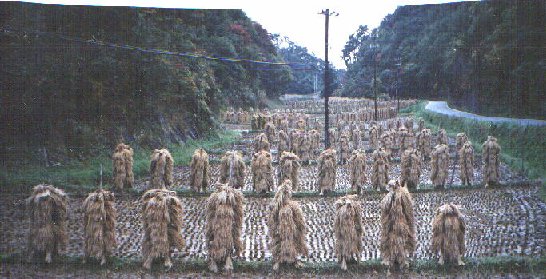Subj: Planting rice in Japan Section: General Information
To: all Sunday, 4. June 1995 22:03:05
From: Joe Wein, 100142,3715 #102304
Last Saturday I went cycling with my baby son, around the backstreets
of the little town west of Tokyo where I live.
It seems to be the rice planting season right now, all the paddies were
full of water and I saw a lot of farmers planting the seedlings into the
mud. For the first time I saw somebody use a rice planting machine. It's
like a sled with two driving wheels that slides on the mud. You take a tray
that holds the green seedlings and put it on the back of the machine which
picks them up one at a time and sticks them into the mud. These trays are
made of plastic and sometimes you see a lot of them in the paddies where
the seedlings have been grown from rice grains for planting. All the
farmers I saw used exactly the same kind of tray, it seems to be an
industry standard. I saw more farmers planting rice by hand which must
be really hard on their back than I saw people use those machines. I guess
if the average farm size is one ha (2.5 acres) there is not much to be
gained by mechanising.
Later I cycled across a bridge over a river and I saw a farmer and his
wife down by the river bank, washing the thin coat of mud off those seedling
trays. They used a cloth to wipe it over and over, until they were so clean
you could have eaten off them. I even saw the farmer pick up one of they
trays from the clean pile and wipe it once more with the wet cloth even
though to me it looked perfectly clean already. It reminded me of all those
shiny trucks that you see in Japan. When I mentioned to my wife about
carefully they cleaned those planting trays she explained how Japanese
like to keep the tools of their trade in perfect condition.
Then I was thinking, this is very unique. Right now I'm paying about $55
for a 10 kg (22 lb) bag of Japanese rice, six times more than the world
market average. It is me as a consumer who is paying for those clean trays.
Maybe in ten years no Japanese farmer will have the time to waste on these
trays as imports of U.S. or Australian grown rice will have forced them to
compete, to have larger and more efficient farms and to use more machines
to farm more land with fewer people. The same thing may happen to those
clean trucks with their polished bits of chrome after transport is deregulated
to make businesses more competitive. An old way of life will be lost for
others to gain.
A few days earlier I saw the emperor walk into a rice paddy on the grounds
of the Imperial Palace in the heart of Tokyo to plant some rice (on TV).
That rice will be used in religious shinto ceremonies later in the year.
The figurehead of the Japanese nation a rice farmer -- with images like
these embedded in the Japanese psyche it is difficult for them to see rice
as just one kind of food amonst many others.
Joe
| 
